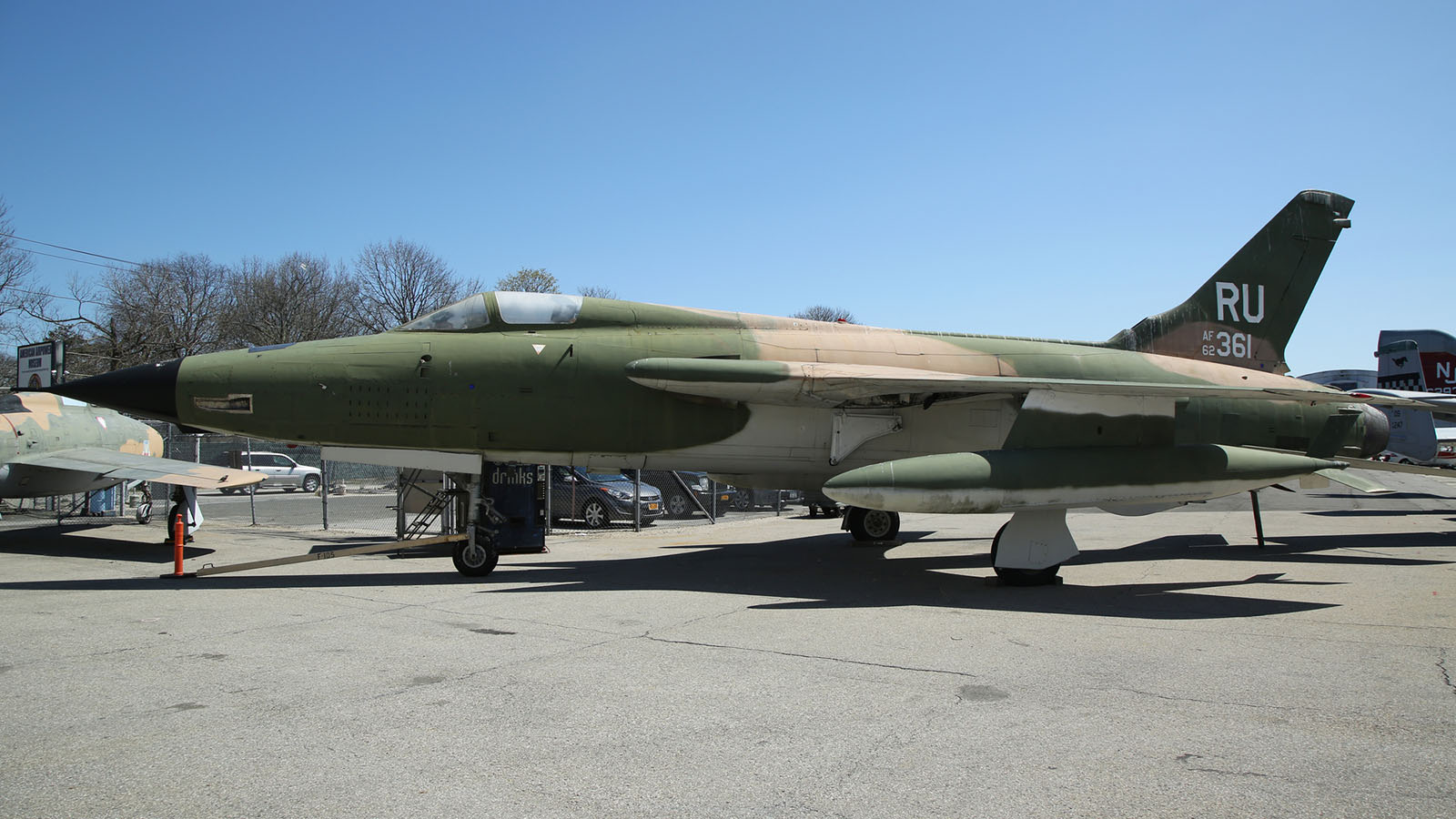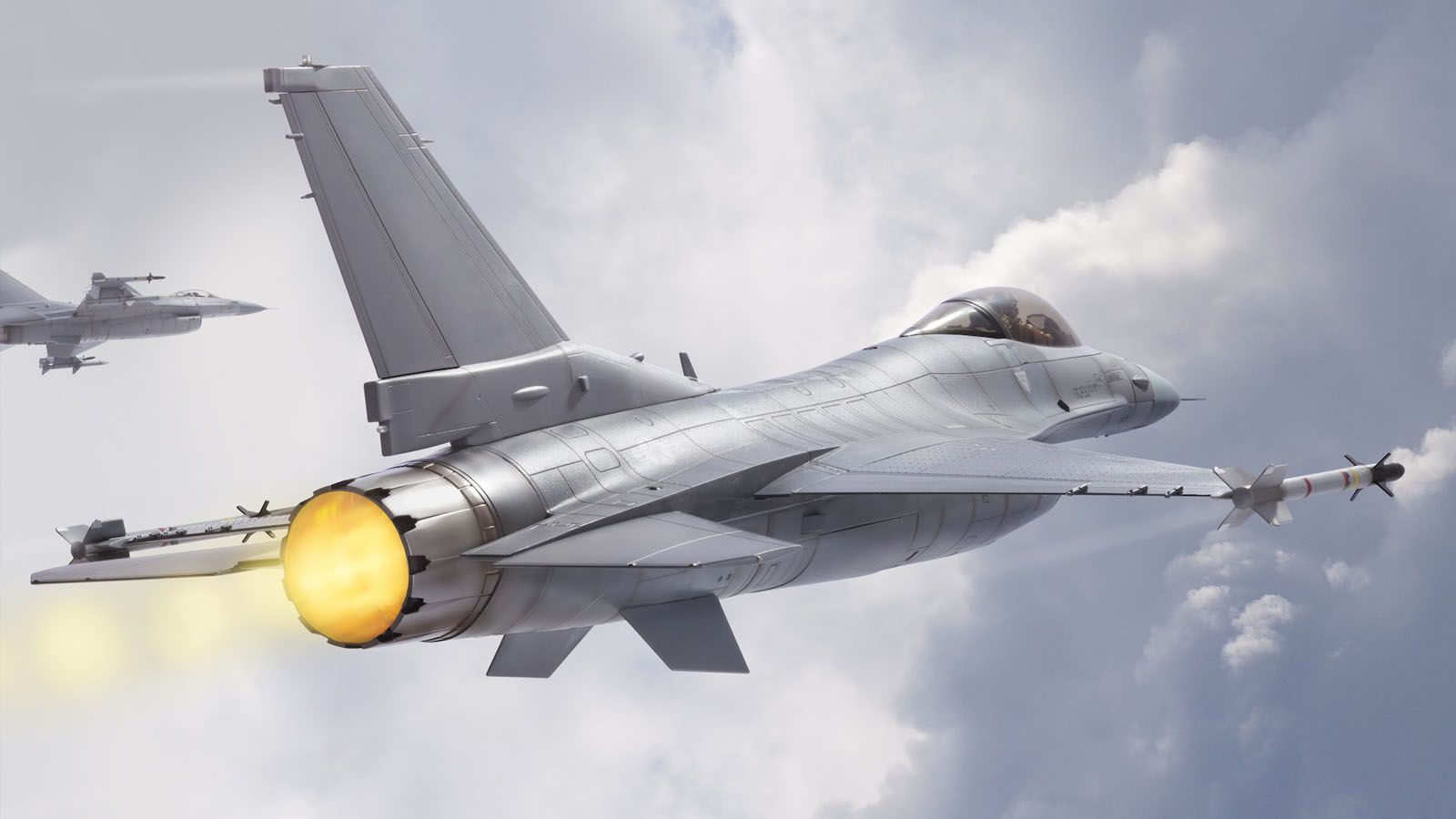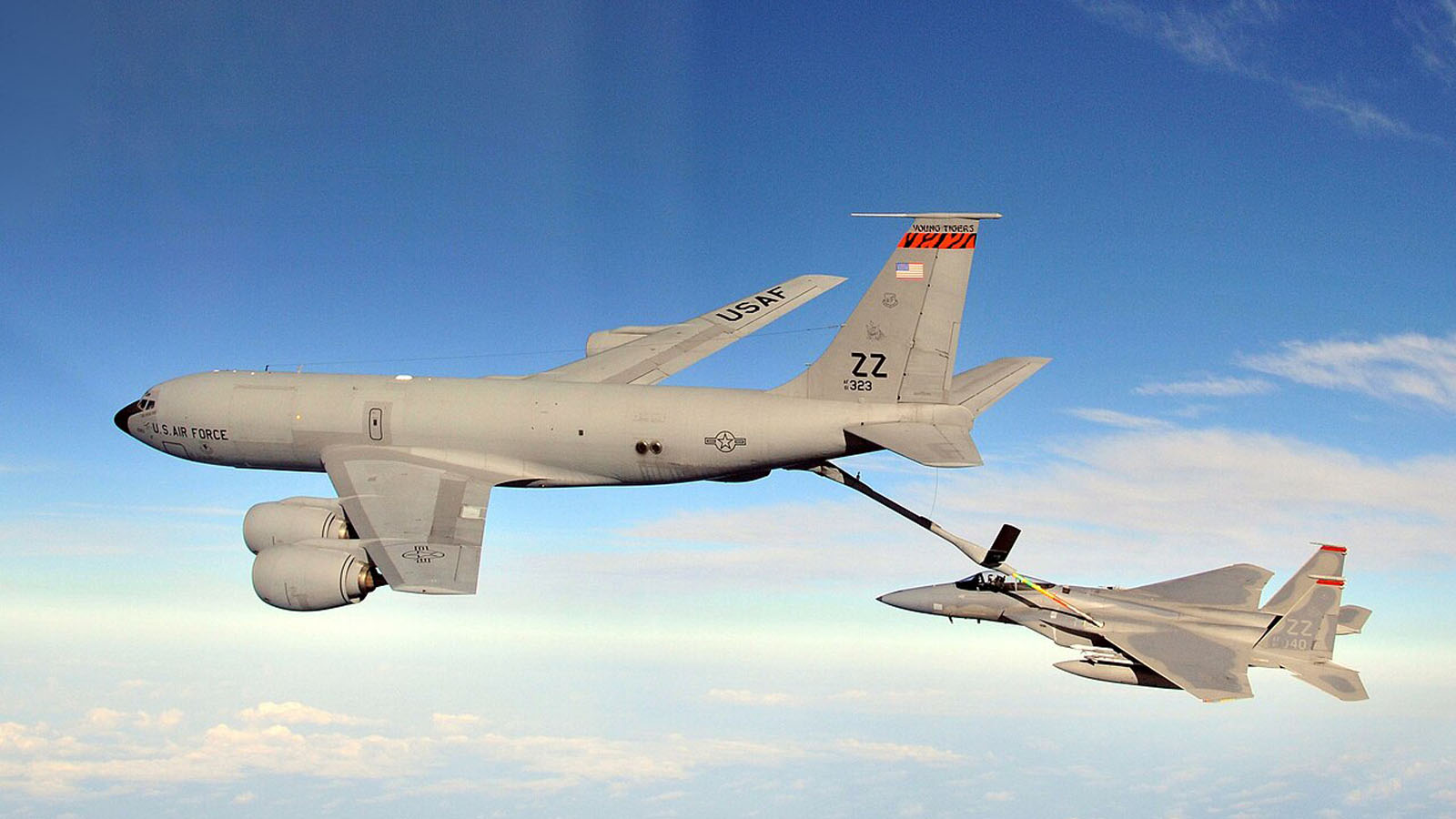F-100 Super Sabre
The USAF F-100 Fighter Jet, with its impressive statistics and capabilities, has left a lasting impact on the world of aviation.
With a top speed of over 800 miles per hour and the ability to carry up to 7,000 pounds of ordnance, this aircraft was a force to be reckoned with.
Developed in the late 1950s by North American Aviation, the F-100 boasted several key features that set it apart from its predecessors. Its innovative design included advanced aerodynamics and a powerful Pratt & Whitney J57 engine.
The F-100 also played a significant role in various military operations throughout its operational history. From serving as an air superiority fighter during the Vietnam War to providing close air support for ground troops, this jet proved its worth time and again.
Over the years, notable variants and upgrades were made to enhance its performance further.
Today, we delve into the development, capabilities, successes, variations, and overall legacy of this iconic fighter jet – the USAF F-100.

Development and Design of the F-100 Fighter Jet
The development and design of the F-100 fighter jet resulted from extensive research and collaboration between multiple aerospace companies. In the early 1950s, the United States Air Force (USAF) recognized the need for a high-performance supersonic aircraft to replace its aging fleet. This led to competition among manufacturers, including North American Aviation, Republic Aviation Corporation, and Lockheed Aircraft Corporation.
North American Aviation ultimately won the contract in 1951 and began working on the F-100 Super Sabre. The design team faced numerous challenges as they aimed to create an aircraft that could fly at supersonic speeds and be highly maneuverable. They incorporated several innovative features into the F-100, such as swept wings and an afterburner system.
The swept-wing design allowed for better performance at high speeds by reducing drag and improving stability. It also enabled shorter takeoff and landing distances, making it more versatile for different operational environments. The afterburner system significantly enhanced thrust during combat, providing additional power when needed.
Another critical aspect of the F-100’s development was its advanced electronics systems. The aircraft featured radar technology for improved navigation and target acquisition capabilities. It also had a sophisticated weapons control system that allowed pilots to engage targets from long distances effectively.
Throughout its service with the USAF, the F-100 underwent several upgrades to enhance its capabilities further. These included improvements in engine performance, avionics systems, and armament options.
In conclusion, developing and designing the F-100 fighter jet involved extensive research and collaboration among multiple aerospace companies. The resulting aircraft showcased cutting-edge technologies like swept wings and an afterburner system while incorporating advanced electronics for superior combat effectiveness.
Key Features and Capabilities of the F-100
Get ready to be blown away by this high-performance aircraft’s incredible vital features and capabilities—it’s like nothing you’ve ever seen!
The F-100 Super Sabre, a remarkable fighter jet developed by the United States Air Force (USAF), was designed to surpass all expectations regarding speed and maneuverability. With its sleek and aerodynamic design, this aircraft can reach speeds exceeding Mach 1. It is equipped with an afterburner that can provide an impressive thrust, allowing it to climb rapidly and perform quick evasive maneuvers.
One of the standout features of the F-100 is its exceptional firepower. This fighter jet is armed with four 20mm cannons, each capable of firing at over 1,500 rounds per minute. Additionally, it can carry a wide range of air-to-air missiles and bombs, making it a versatile weapon on the battlefield.
Not only does the F-100 possess incredible offensive capabilities, but it also excels in defense. Advanced radar systems enable pilots to detect enemy aircraft from great distances. This allows for early warning detection and gives pilots ample time to react accordingly.
Furthermore, the F-100 boasts excellent maneuverability due to its unique swept-wing design. This configuration reduces drag and increases lift at high speeds, resulting in superior performance during dogfights or evasion tactics.
Overall, the F-100 Super Sabre is a testament to technological advancement in military aviation. Its speed, firepower, and agility make it an indispensable asset for any air force seeking dominance in aerial combat.
Operational History and Successes of the F-100
Imagine yourself in the cockpit of the F-100 Super Sabre, flying over enemy territory and completing a high-risk mission with precision and skill. The operational history of the F-100 is filled with numerous successes demonstrating its capability as a fighter jet.
The F-100 was crucial during the Vietnam War, primarily for close air support missions. Its speed, agility, and firepower made it influential in engaging ground targets. The aircraft’s ability to deliver accurate strikes at low altitudes allowed it to provide valuable assistance to troops on the ground.
One notable success of the F-100 was its participation in Operation Rolling Thunder, which aimed to disrupt North Vietnamese logistics and supply lines. The aircraft’s versatility enabled it to carry out bombing runs and strafing attacks effectively. It proved instrumental in destroying enemy infrastructure such as bridges, roads, and supply depots.
Additionally, the F-100 excelled in air-to-air combat engagements. Advanced avionics systems enhanced pilots’ situational awareness, giving them an edge over their adversaries. D ring the war, F-100s achieved multiple aerial victories against enemy MiG fighters.
Beyond Vietnam, the F-100 also served with distinction during other conflicts, such as Operation Desert Storm and Operation Allied Force. Its robust design and exceptional performance capabilities ensured its relevance even amidst evolving warfare technologies.
In conclusion, the operational history of the F-100 Super Sabre is marked by countless successes in close air support missions and air-to-air combat engagements. Its effectiveness as a fighter jet is evident through its contributions during significant historical conflicts.
Notable Variants and Upgrades of the F-100
As you climb into the cockpit of the F-100 Super Sabre, picture yourself experiencing the enhanced capabilities of its notable variants and upgrades.
Throughout its operational history, the F-100 underwent several changes throughout its operational history s to adapt to evolving combat requirements.
One of the most significant variants was the F-100D, which featured improved avionics and an upgraded engine. This variant also introduced a more advanced fire control system, enabling pilots to engage targets accurately. It also increased fuel capacity and improved range, allowing for extended missions.
Another notable variant was the F-100F Wild Weasel II, designed explicitly for the Suppression of Enemy Air Defenses (SEAD) missions. Equipped with specialized electronic warfare systems and radar-seeking missiles, this variant was crucial in neutralizing enemy surface-to-air missile threats during conflicts like the Vietnam War.
In terms of upgrades, one prominent example is the F-100C’s conversion to become an unmanned target drone known as QF-100. This modification enabled it to be a realistic training and weapon-testing target.
Furthermore, many F-100s were retrofitted with aerial refueling capability by adding external fuel tanks or installing inflight refueling probes. T’s upgrade significantly extended their operational reach by allowing them to receive fuel mid-flight from tanker aircraft.
These notable variants and upgrades transformed the F-100 Super Sabre into a versatile and adaptable fighter jet that could fulfill various mission profiles. As you take off in this iconic aircraft, you will have complete confidence in its enhanced capabilities provided by these advancements.
Legacy and Impact of the F-100 Fighter Jet
The legacy of the F-100 Super Sabre reverberates through the annals of aviation history, leaving an indelible mark on future generations of military aircraft. The first supersonic jet fighter in service with the United States Air Force (USAF), the F-100 set a new standard for speed and performance. Its impact can be seen not only in its successful combat missions but also in its advancements in aviation technology.
One of the notable advancements introduced by the F-100 was its use of a low-mounted swept-wing design, significantly improving its aerodynamic capabilities. T’s design allowed for better maneuverability at high speeds and reduced drag, enabling pilots to achieve unprecedented dogfight agility. The F-100 also featured an afterburner that significantly increased thrust, allowing it to reach supersonic speeds.
To convey a deeper understanding of the F-100’s impact, let us examine a comparison between this iconic fighter jet and its predecessor, the F-86 Sabre:
| F-86 Sabre | F-100 Super Sabre | |
|---|---|---|
| First Flight | 1947 | 1953 |
| Top Speed | March 1.25 | Mach 1.25 |
| Radar | None | APG-30 |
| Service Ceiling | 49,000 ft | 50,000 ft |
| Armament | Six .50 caliber machine guns | Four M39 cannon |
This table highlights key differences between these two aircraft and emphasizes how the F-100 surpassed its predecessor in speed, altitude capabilities, radar technology, and armament.
In conclusion, the legacy of the F-100 Super Sabre is undeniable. Its groundbreaking design and technological advancements paved the way for future generations of military aircraft. The impact on aviation history is still felt today, serving as a testament to the ingenuity and engineering prowess of the United States Air Force.
Frequently Asked Questions
How many F-100 Fighter Jets were produced by the USAF?
The United States Air Force (USAF) produced 2,294 F-100 Super Sabre fighter jets. These, a total of 1,274, were F-100D fighter jets.
The F-100 was a famous aircraft and played a crucial role during its service period. Its production ran from 1953 to 1959 and was eventually replaced by more advanced models like the F-105 Thunderchief.
Can the F-100 Fighter Jet perform aerial refueling?
Yes, the F-100 fighter jet can perform aerial refueling. T’s capability allows the F-100 to extend its range and endurance during missions without landing and refueling.
What were the primary challenges faced during the development of the F-100 Fighter Jet?
The primary challenges of developing the F-100 fighter jet were ensuring sufficient engine power and creating a suitable airframe to handle high speeds.
The aircraft had to be capable of flying at supersonic speeds, which required innovative design solutions to reduce drag and maintain stability.
Additionally, advancements in materials and manufacturing techniques were necessary to ensure durability and structural integrity under intense flight conditions.
Did the F-100 Fighter Jet see combat in any major conflicts?
The United States Air Force heavily used the F-100 Fighter Jet during the Vietnam War. D ring this time, it performed various roles, such as ground attack and close air support.
How does the F-100 Fighter Jet compare to other fighter jets of its time in terms of speed and maneuverability?
The F-100 fighter jet was highly regarded among its contemporaries. I possessed exceptional agility and a remarkable top speed, allowing it to outperform many other fighter jets of its time.
The F-100’s performance capabilities were widely recognized and contributed to its success in various missions during significant conflicts.
Conclusion
In conclusion, the USAF F-100 Fighter Jet was a revolutionary aircraft that left an indelible mark on aviation history.
With its sleek design and advanced capabilities, it soares the skies with precision and power.
From its successful operational missions to its various upgraded variants, the F-100 proved to be a force to be reckoned with.
As we reflect on its legacy, we can’t help but envision the blazing trails it left behind, forever etching itself into the annals of military aviation.










